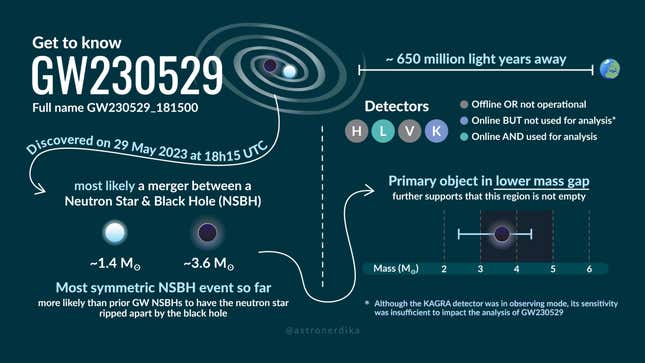A leading gravitational wave observatory recently detected ripples in spacetime that scientists say came from the collision of a dead, superdense stellar remnant and an unknown object.
The stellar remnant is what’s called a neutron star; it’s what is left when a massive star collapses, leaving only a dense core behind. Neutron stars are some of the densest objects in the universe, with intense gravitational fields—but not as intense as black holes, whose gravity is so strong that not even light can escape their event horizons.
Advertisement
These two cosmic juggernauts dance and clash across the universe; the first confirmation of an observed merger between a neutron star and a black hole was made in 2021. Their interactions produce gravitational waves—literally, stretches and squeezes of spacetime—which are detected by observatories like the LIGO-Virgo-KAGRA Collaboration, which is at the heart of the latest research.
Advertisement
LIGO-Virgo-KAGRA detected a gravitational wave signal in May 2023, just days after the observatory resumed operations following some upgrades that reduced the amount of noise in the detector, improving its sensitivity to the subtle perturbations of spacetime.
Advertisement
The unique gravitational wave signal travelled 650 million light-years to get to the LIGO Livingston Observatory in Louisiana. Researchers determined the signal came from the merger of two objects. One of the objects was between 1.2 and 2 times the mass of our Sun, and the other was about 2.5 to 4.5 solar masses. The signal is dubbed GW230529_181500, or GW230529 for short.
The smaller object, the astrophysicists concluded, is probably a neutron star. But the larger object is more massive than any known neutron star, indicating that it may be an itsy-bitsy black hole. Their paper describing the signal and its likely origins is currently hosted on the LIGO website.
The unknown object occupies the apparent mass gap that exists between the heaviest known neutron star and the lightest black hole. Further scrutiny of the collision will indicate whether the unknown object is a low-mass black hole, as the team suspects, or something else.
Advertisement
The detection “reveals that there may be a higher rate of similar collisions between neutron stars and low-mass black holes than we previously thought,” said Jess McIver, an astronomer at the University of British Columbia and Deputy Spokesperson of the LIGO Scientific Collaboration, in a collaboration release.
The release noted that out of nearly 200 measurements of compact object masses, only one other merger involved an object in the apparent mass gap, that one merging with a black hole. (For gravitational wave connoisseurs, that signal was GW190814.) But the recent observation was the first between a mass-gap object and a neutron star.
Advertisement
LIGO-Virgo-KAGRA’s fourth observing run will restart on April 10 and will continue without planned breaks until February 2025, by which time the collaboration anticipates more than 200 gravitational wave signals will have been observed.

Advertisement
It’s been a productive couple of years for gravitational wave science, with more excitement on the horizon. Last year, a handful of pulsar timing consortia independently confirmed the first signs of a gravitational wave background—the constant murmur of gravitational waves throughout the universe which they believe comes from the dances of supermassive black hole binaries.
Earlier this year, ESA formally adopted plans for LISA, a space-based gravitational wave observatory. LISA would consist of three spacecraft spinning through space in a triangular formation. LISA will listen for gravitational waves without any of the noise that occurs on Earth, which can clutter the data collected by LIGO-Virgo-KAGRA.
Advertisement
There are still 80 significant signal candidates that the team needs to sift through. So there are heady days ahead for observing the gravitational universe.
More: These Violent Collisions Could Be Producing Dark Matter
Services Marketplace – Listings, Bookings & Reviews